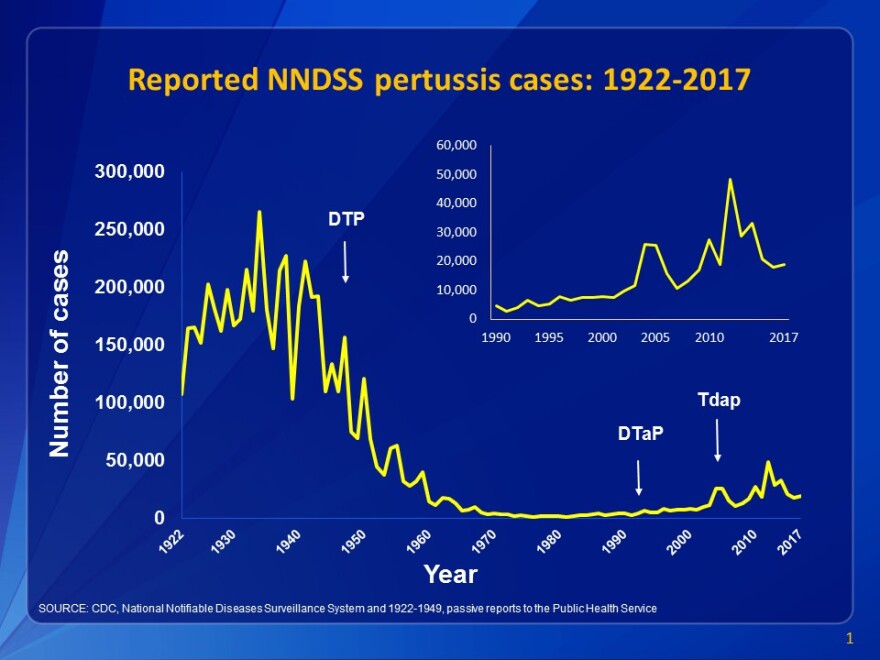Missoula County health officials are investigating an outbreak of whooping cough that has sickened at least six Missoulians. Local health officials have identified hundreds more who may have been exposed to the contagious respiratory disease.
"We haven’t had an outbreak of this size with this range of ages in different schools since about 2012," says Missoula City-County Health Department Director Ellen Leahy.
She says the six confirmed cases range in age from preschool to teenagers. One patient required hospitalization.
As of Wednesday, five other whooping cough cases were suspected, pending lab results. A mix of vaccinated and unvaccinated children are among the cases. Over 300 others may have been exposed to the contagious disease that’s also called pertussis.
"It can cause a really bad cough, and the fits of coughing can be so severe that people have trouble catching their breath," Leahy says.
That’s where whooping cough gets its name; patients try so hard to get air during one of those fits, they make an odd whooping sound.
This is what whooping cough sounds like in an adult as captured in a video posted to YouTube by the NEJM medical research group.
https://www.youtube.com/watch?v=31tnXPlhA7w
"It can also be so severe they just get exhausted from the cough. Sometimes children, even adults, may vomit. Unfortunately, if you don’t catch the disease early and get an antibiotic into your system, this cough can last for a few months."
Leahy and her team at Missoula City-County Health are racing to quickly identify as many cases as possible.
"It’s the kind of disease that once it gets rolling you really have to jump on it."
Over the past week, health department nurses have fanned out into local schools conducting detective work. They’re asking lots questions to determine which students may have been in close contact with existing whooping cough patients. "Close contact" in this case means about 3 feet.
"We call it 'spitting distance', actually," Leahy says.
When a so-called "close contact" is confirmed, officials notify that person or their parent or guardian. The best medical option at that point is a prescription for antibiotics.

Parents hesitant about that treatment course are urged to closely monitor their kid for symptoms, and stay in close contact with health officials
During the disease’s initial stages those symptoms are fairly nondescript; low fever, runny nose and a mild cough. But if that cough gets persistent and more intense, patients are urged to seek treatment as soon as possible. Babies less than a year old, those with compromised immune systems and the unvaccinated are particularly susceptible.
There is a pertussis vaccination. Leahy points out it provides good protection, but adds it is not a silver bullet.
"This one is somwhere in the 80 percent effective, which is good, but the disease can break through. People who are vaccinated, generally, if they get the disease will have a lesser form of the disease. They are, however, contagious. So, if they feel well enough to go to work and go to school they’re actually spreading the disease."
A pertussis booster-shot for adults developed about 12 years ago is also available. It’s part of the tetanus shot.
"So if you haven’t had a shot for this in the last 12 years, if you’re of that adult age, you probably didn’t get the pertussis booster," Leahy says.
Pregnant women are urged to update their vaccinations, even if they were fully immunized before pregnancy. Newborns can’t be vaccinated until they’re 2 months old.
https://www.youtube.com/watch?v=SkafS5pwMuo&feature=youtu.be
Missoula City County Health continues its pertussis investigation in local schools. Officials are taking a 'Don’t call us, we’ll call you' approach, meaning they will call parents if there’s a health concern.
Meanwhile, Leahy urges Missoulians to listen to their bodies.
"To just write off a persistent cough right now would not be a wise thing to do."
Missoula county has established a special pertussis information hotline. That phone number is 406-258-INFO (4636).
The federal Centers for Disease Control and Prevention says Pertussis is a common disease in the U.S., with peaks in reported cases every few years and frequent outbreaks. In 2012, the most recent peak year, more than 48,000 cases were reported nationwide, many more cases go unreported.

Learn more about Pertussis from the Centers For Disease Control.


